Time Travel Research Center © 2005 Cetin BAL - GSM:+90 05366063183 - Turkey/Denizli
Nuclear Fission Bombs
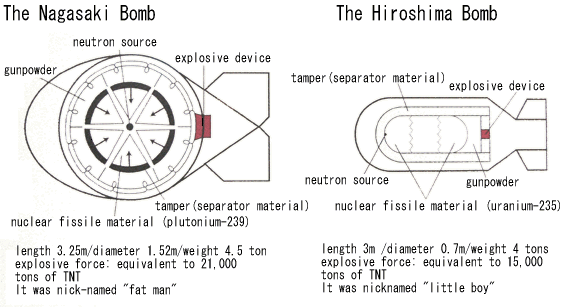
Nuclear Weapons
Nuclear Weapons, explosive devices, designed
to release nuclear energy on a large scale, used primarily in
military applications. The first atomic bomb (or A-bomb), which was tested
on July 16, 1945, at Alamogordo, New Mexico, represented a completely new
type of artificial explosive. All explosives prior to that time
derived their power from the rapid burning or decomposition of some
chemical compound. Such chemical processes release only the energy of
the outermost electrons in the atom.
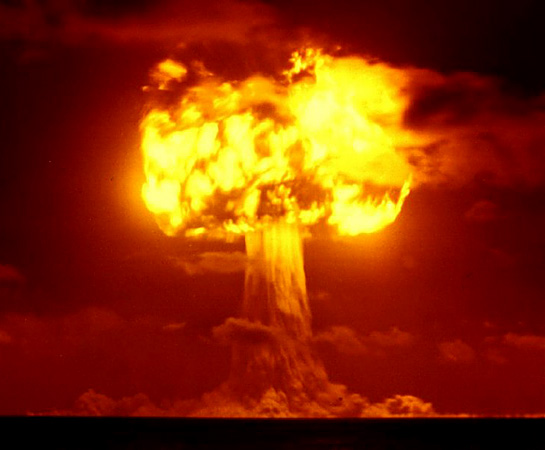
Deadly Mushroom Cloud over Hiroshima
On August 6, 1945, during World War II, the United States dropped an atomic
bomb on Hiroshima, a Japanese city and military center. About 130,000 people
were reported killed, injured, or missing. Another 177,000 were made
homeless. It was the first atomic bomb used against an enemy.
Nuclear explosives, on the other hand, involve energy sources within the core, or nucleus, of the atom. The A-bomb gained its power from the splitting, or fission, of all the atomic nuclei in several kilograms of plutonium. A sphere about the size of a baseball produced an explosion equal to 20,000 tons of TNT.
The A-bomb was developed, constructed, and tested by the Manhattan Project, a massive United States enterprise that was established in August 1942, during World War II. Many prominent American scientists including the physicists Enrico Fermi and J. Robert Oppenheimer, and the chemist Harold Urey, were associated with the project, which was headed by a U.S. Army engineer, Major General Leslie Groves.
After the war, the U.S. Atomic Energy Commission became responsible for the oversight of all nuclear matters, including weapons research. Other types of bombs were developed to tap the energy of light elements, such as hydrogen. In these bombs the source of energy is the fusion process, in which nuclei of the isotopes of hydrogen combine to form a heavier helium nucleus. This weapons research has resulted in the production of bombs that range in power from a fraction of a kiloton (1000 tons of TNT equivalent) to many megatons (1 million tons of TNT equivalent). Furthermore, the physical size of the bomb has been drastically reduced, permitting the development of nuclear artillery shells and small missiles that can be fired from portable launchers in the field. Although nuclear bombs were originally developed as strategic weapons to be carried by large bombers, nuclear weapons are now available for a variety of both strategic and tactical applications. Not only can they be delivered by different types of aircraft, but rockets and guided missiles of many sizes can now carry nuclear warheads and can be launched from the ground, the air, or underwater. Large rockets can carry multiple warheads for delivery to separate targets.
Fission Weapons
In 1905 Albert Einstein published his special theory of relativity.
According to this theory, the relation between mass and energy is expressed
by the equation E = mc2, which states that a given mass (m) is associated
with an amount of energy (E) equal to this mass multiplied by the square of
the speed of light (c). A very small amount of matter is equivalent to a
vast amount of energy. For example, 1 kg (2.2 lb) of matter converted
completely into energy would be equivalent to the energy released by
exploding 22 megatons of TNT.
In 1939, as a result of experiments by the German chemists Otto Hahn and Fritz Strassmann (1902-80), who split the uranium atom into two roughly equal parts by bombardment with neutrons See Neutron, the Austrian physicist Lise Meitner, with her nephew, the British physicist Otto Robert Frisch (1904-79), explained the process of nuclear fission, which placed the release of atomic energy within reach.
The Chain Reaction
When the uranium or other suitable nucleus fissions, it breaks up into a
pair of nuclear fragments and releases energy. At the same time, the nucleus
emits very quickly a number of fast neutrons, the same type of particle that
initiated the fission of the uranium nucleus. This makes it possible to
achieve a self-sustaining series of nuclear fissions; the neutrons
that are emitted in fission produce a chain reaction, with continuous
release of energy.
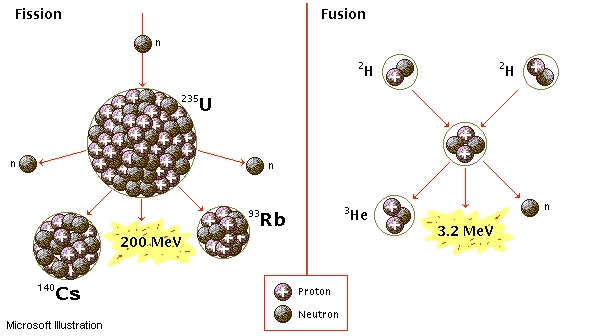
Nuclear Fission and Nuclear Fusion
Both nuclear fission and nuclear fusion reactions can be used to generate
large amounts of energy for destructive purposes. When an atom of 235U is
bombarded by a neutron, it splits into atoms of cesium and rubidium,
releasing a large amount of energy and three additional neutrons. These
neutrons, if not controlled, can then cause more 235U atoms to split,
leading rapidly to a nuclear explosion (A-bomb). Fusion reactions release
energy when two light nuclei combine to make a heavier atom.

Fission Bomb
The first atomic bomb used in warfare was dropped by the United States on
August 6, 1945. Called Little Boy, it produced an explosion that devastated
the city of Hiroshima in Japan and killed tens of thousands of people in
less than one minute. In this bomb, a mass of uranium about the size of a
baseball produced an explosion as powerful as 20 kilotons of TNT. Little
Boy, which is schematized here, was a gun-type fission bomb. A small wedge
of uranium was fired at a larger target piece of uranium and, upon impact,
the two pieces fused together briefly, forming what is called a
supercritical mass (a mass slightly greater than that necessary to sustain a
chain reaction).
The light isotope of uranium, uranium-235, is easily split by the fission neutrons and, upon fission, emits an average of about 2.5 neutrons. One neutron per generation of nuclear fissions is necessary to sustain the chain reactions. Others may be lost by escape from the mass of chain-reacting material, or they may be absorbed in impurities or in the heavy uranium isotope, uranium-238, if it is present. Any substance capable of sustaining a fission chain reaction is known as a fissile material.
Critical Mass
A small sphere of pure fissile material, such as uranium-235, about the
size of a golf ball, would not sustain a chain reaction. Too many neutrons
escape through the surface area, which is relatively large compared with its
volume, and thus are lost to the chain reaction. In a mass of uranium-235
about the size of a baseball, however, the number of neutrons lost through
the surface is compensated for by the neutrons generated in additional
fissions taking place within the sphere. The minimum amount of fissile
material (of a given shape) required to maintain the chain reaction is known
as the critical mass. Increasing the size of the sphere produces a
supercritical assembly, in which the successive generations of fissions
increase very rapidly, leading to a possible explosion as a result of the
extremely rapid release of a large amount of energy. In an atomic bomb,
therefore, a mass of fissile material greater than the critical size must be
assembled instantaneously and held together for about a millionth of a
second to permit the chain reaction to propagate before the bomb explodes. A
heavy material, called a tamper, surrounds the fissile mass and prevents its
premature disruption. The tamper also reduces the number of neutrons that
escape.
If every atom in 0.5 kg (1.1 lb) of uranium were to split, the energy produced would equal the explosive power of 9.9 kilotons of TNT. In this hypothetical case, the efficiency of the process would be 100 percent. In the first A-bomb tests, this kind of efficiency was not approached. Moreover, a 0.5-kg (1.1-lb) mass is too small for a critical assembly.
Detonation of Atomic Bombs
Various systems have been devised to detonate the atomic bomb. The simplest
system is the gun-type weapon, in which a projectile made of fissile
material is fired at a target of the same material so that the two weld
together into a supercritical assembly. The atomic bomb exploded by the
United States over Hiroshima, Japan, on August 6, 1945, was a gun-type
weapon. It had the energy of anywhere between 12.5 to 15 kilotons of
TNT. Three days later the United States dropped a second atomic bomb over
Nagasaki, Japan, with the energy equivalent of close to 22 kilotons
of TNT.

First Atomic Bomb
Developed by American scientists, the first atomic bomb was detonated at the
Trinity test site near Alamogordo, New Mexico, on July 16, 1945. The test
convinced the United States government that such weapons were viable in
warfare.
A more complex method, known as implosion, is utilized in a spherically shaped weapon. The outer part of the sphere consists of a layer of closely fitted and specially shaped devices, called lenses, consisting of high explosive and designed to concentrate the blast toward the center of the bomb. Each segment of the high explosive is equipped with a detonator, which in turn is wired to all other segments. An electrical impulse explodes all the chunks of high explosive simultaneously, resulting in a detonation wave that converges toward the core of the weapon. At the core is a sphere of fissile material, which is compressed by the powerful, inwardly directed pressure, or implosion. The density of the metal is increased, and a supercritical assembly is produced. The Alamogordo test bomb, as well as the one dropped by the U.S. on Nagasaki, Japan, on August 9, 1945, were of the implosion type. Each was equivalent to about 20 kilotons of TNT.
Regardless of the method used to attain a supercritical assembly, the chain reaction proceeds for about a millionth of a second, liberating vast amounts of heat energy. The extremely fast release of a very large amount of energy in a relatively small volume causes the temperature to rise to tens of millions of degrees. The resulting rapid expansion and vaporization of the bomb material causes a powerful explosion.
Production of Fissile Material
Much experimentation was necessary to make the production of fissile
material practical.
Separation of Uranium Isotopes
The fissile uranium-235 isotope accounts for only 0.7 percent of natural
uranium; the remainder is composed of the heavier uranium-238. No chemical
methods suffice to separate uranium-235 from ordinary uranium, because both
uranium isotopes are chemically identical. A number of techniques
were devised to separate the two, all of which depend in principle on the
slight difference in weight between the two types of uranium atoms.
A huge gaseous-diffusion plant was built during World War II in Oak Ridge, Tennessee. This plant was enlarged after the war, and two similar plants were built near Paducah, Kentucky, and Portsmouth, Ohio. The feed material for this type of plant consists of extremely corrosive uranium hexafluoride gas, UF. The gas is pumped against barriers that have many millions of tiny holes, through which the lighter molecules, which contain uranium-235 atoms, diffuse at a slightly greater rate than the heavier molecules, containing uranium-238. After the gas has been cycled through thousands of barriers, known as stages, it is highly enriched in the lighter isotope of uranium. The final product is weapon-grade uranium containing more than 90 percent uranium-235.
Producing Plutonium
Although the heavy uranium isotope uranium-238 will not sustain a chain
reaction, it can be converted into a fissile material by bombarding it with
neutrons and transforming it into a new species of element. When the uranium-238
atom captures a neutron in its nucleus, it is transformed into the heavier
isotope uranium-239. This nuclear species quickly disintegrates to form
neptunium-239, an isotope of element 93. Another disintegration transmutes
this isotope into an isotope of element 94, called plutonium-239. Plutonium-239,
like uranium-235, undergoes fission after the absorption of a neutron and
can be used as a bomb material. Producing plutonium-239 in large quantities
requires an intense source of neutrons; the source is provided by the
controlled chain reaction in a nuclear reactor.
During World War II nuclear reactors were designed to provide neutrons to produce plutonium. Reactors capable of manufacturing large quantities of plutonium were established in Hanford, Washington, and near Aiken, South Carolina.
Nuclear fission
Nuclear fission is a process in which the nucleus of a heavy atom is broken apart into two or more smaller nuclei. The reaction was first discovered in the late 1930s when a target of uranium metal was bombarded with neutrons. Uranium nuclei broke into two smaller nuclei of roughly equal size with the emission of very large amounts of energy. Some scientists immediately recognized the potential of the nuclear fission reaction for the production of bombs and other types of weapons as well as for the generation of power for peacetime uses.
History
The fission reaction was discovered accidentally in 1938 by two German physicists, Otto Hahn (18791968) and Fritz Strassmann (19021980). Hahn and Strassmann had been doing a series of experiments in which they used neutrons to bombard various elements. When they bombarded copper, for example, a radioactive form of copper was produced. Other elements became radioactive in the same way.
Their work with uranium, however, produced entirely different results. In fact, the results were so unexpected that Hahn and Strassmann were unable to offer a satisfactory explanation for what they observed. That explanation was provided, instead, by German physicist Lise Meitner (18781968) and her nephew Otto Frisch (19041979). Meitner was a longtime colleague of Hahn who had left Germany due to anti-Jewish persecution.
In most nuclear reactions, an atom changes from a stable form to a radioactive form, or it changes to a slightly heavier or a slightly lighter atom. Copper (element number 29), for example, might change from a stable form to a radioactive form or to zinc (element number 30) or nickel (element number 28). Such reactions were already familiar to nuclear scientists.
What Hahn and Strassmann had seenand what they had failed to recognizewas a much more dramatic nuclear change. An atom of uranium (element number 92), when struck by a neutron, broke into two much smaller elements such as krypton (element number 36) and barium (element number 56). The reaction was given the name nuclear fission because of its similarity to the process by which a cell breaks into two parts during the process of cellular fission.
Putting nuclear fission to work
In every nuclear fission, three kinds of products are formed. The first product consists of the smaller nuclei produced during fission. These nuclei, like krypton and barium in the example mentioned above, are called fission products. Fission products are of interest for many reasons, one of which is that they are always radioactive. That is, any time a fission reaction takes place, radioactive materials are formed as by-products of the reaction.
Words to Know
Chain reaction: A reaction in which a substance needed to initiate a reaction is also produced as the result of that reaction.
Fission products: The isotopes formed as the result of a nuclear fission reaction.
Fission weapon: A bomb or other type of military weapon whose power is derived from a nuclear fission reaction.
Isotopes: Two or more forms of an element that have the same chemical properties but that differ in mass because of differences in the number of neutrons in their nuclei.
Manhattan Project: A research project of the United States government created to develop and produce the world's first atomic bomb.
Mass: A measure of the amount of matter in a body.
Neutron: A subatomic particle with a mass about equal to that of a hydrogen atom but with no electric charge.
Nuclear reactor: Any device for controlling the release of nuclear power so that it can be used for constructive purposes.
Radioactivity: The property possessed by some elements of spontaneously emitting energy in the form of particles or waves by disintegration of their atomic nuclei.
Radioactive isotope: An isotope that spontaneously breaks down into another isotope with the release of some form of radiation.
Subatomic particle: Basic unit of matter and energy (proton, neutron, electron, neutrino, and positron) smaller than an atom.
The second product of a fission reaction is energy. A tiny amount of matter in the original uranium atom is changed into energy. In the early 1900s, German-born American physicist Albert Einstein (18791955) had showed how matter and energy can be considered two forms of the same phenomenon. The mathematical equation that represents this relationship, E = mc2, has become one of the most famous scientific formulas in the world. The formula says that the amount of energy (E) that can be obtained from a certain amount of matter (m) can be found by multiplying that amount of matter by the square of the speed of light (c2). The square of the speed of light is a very large number, equal to about 9 × 1020 meters per second, or 900,000,000,000,000,000,000 meters per second. Thus, if even a very small amount of matter is converted to energy, the amount of energy obtained is very large. It is this availability of huge amounts of energy that originally made the fission reaction so interesting to both scientists and nonscientists.
The third product formed in any fission reaction is neutrons. The significance of this point can be seen if you recall that a fission reaction is initiated when a neutron strikes a uranium nucleus or other large nucleus. Thus, the particle needed to originate a fission reaction is also produced as a result of the reaction.
Chain reactions. Imagine a chunk of uranium metal consisting of trillions upon trillions of uranium atoms. Then imagine that a single neutron is fired into the chunk of uranium, as shown in the accompanying figure of a nuclear chain reaction. If that neutron strikes a uranium nucleus, it can cause a fission reaction in which two fission products and two neutrons are formed. Each of these two neutrons, in turn, has the potential for causing the fission of two other uranium nuclei. Two neutrons produced in each of those two reactions can then cause fission in four uranium nuclei. And so on.
In actual practice, this series of reactions, called a chain reaction, takes place very rapidly. Millions of fission reactions can occur in much less than a second. Since energy is produced during each reaction, the total amount of energy produced throughout the whole chunk of uranium metal is very large indeed.

The first atomic bomb
Perhaps you can see why some scientists immediately saw fission as a way of making very powerful bombs. All you have to do is to find a large enough chunk of uranium metal, bombard the uranium with neutrons, and get out of the way. Fission reactions occur trillions of times over again in a short period of time, huge amounts of energy are released, and the uranium blows apart, destroying everything in its path. Pictures of actual atomic bomb blasts vividly illustrate the power of fission reactions.
But the pathway from the Hahn/Strassmann/Meitner/Frisch discovery to an actual bomb was a long and difficult one. A great many technical problems had to be solved in order to produce a bomb that worked on the principle of nuclear fission. One of the most difficult of those problems involved the separation of uranium-238 from uranium-235.
Naturally occurring uranium consists of two isotopes: uranium-238 and uranium-235. Isotopes are two forms of the same element that have the same chemical properties but different masses. The difference between these two isotopes of uranium is that uranium-235 nuclei will undergo nuclear fission, but those of uranium-238 will not. That problem is compounded by the fact that uranium-238 is much more abundant in nature than is uranium-235. For every 1,000 atoms of uranium found in Earth's crust, 993 are atoms of uranium-238 and only 7 are atoms of uranium-235. One of the biggest problems in making fission weapons a reality, then, was finding a way to separate uranium-235 (which could be used to make bombs) from uranium-238 (which could not, and thus just got in the way).
The Manhattan Project. A year into World War II (193945), a number of scientists had come to the conclusion that the United States would have to try building a fission bomb. They believed that Nazi Germany would soon be able to do so, and the free world could not survive unless it, too, developed fission weapons technology.
Thus, in 1942, President Franklin D. Roosevelt authorized the creation of one of the largest and most secret research operations ever devised. The project was given the code name Manhattan Engineering District, and its task was to build the world's first fission (atomic) bomb. That story is a long and fascinating one, a testimony to the technological miracles that can be produced under the pressures of war. The project reached its goal on July 16, 1945, in a remote part of the New Mexico desert, where the first atomic bomb was tested. Less than a month later, the first fission bomb was actually used in war. It was dropped on the Japanese city of Hiroshima, destroying the city and killing over 80,000 people. Three days later, a second bomb was dropped on Nagasaki, with similar results. For all the horror they caused, the bombs seemed to have achieved their objective. The Japanese leaders appealed for peace only three days after the Nagasaki event. (Critics, however, charge that the end of the war was in sight and that the Japanese would have surrendered without the use of a devastating nuclear weapon.)
Nuclear fission in peacetime
The world first learned about the power of nuclear fission in the form of terribly destructive weapons, the atomic bombs. But scientists had long known that the same energy released in a nuclear weapon could be harnessed for peacetime uses. The task is considerably more difficult, however. In a nuclear weapon, a chain reaction is initiatedenergy is produced and released directly to the environment. In a nuclear power reactor, however, some means must be used to control the energy produced in the chain reaction.
The control of nuclear fission energy was actually achieved before the production of the first atomic bomb. In 1942, a Manhattan Project research team under the direction of Italian physicist Enrico Fermi (19011954) designed and built the first nuclear reactor. A nuclear reactor is a device for obtaining the controlled release of nuclear energy. The reactor had actually been built as a research instrument to learn more about nuclear fission (as a step in building the atomic bomb).
After the war, the principles of Fermi's nuclear reactor were used to construct the world's first nuclear power plants. These plants use the
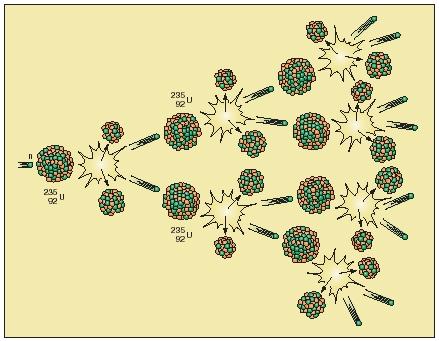
... energy released by nuclear fission to heat water in boilers. The steam that is produced is then used to operate turbines and electrical generators. The first of these nuclear power plants was constructed in Shippingport, Pennsylvania, in 1957. In the following three decades, over 100 more nuclear power plants were built in every part of the United States, and at least as many more were constructed throughout the world.
By the dawn of the 1990s, however, progress in nuclear power production had essentially come to a stop in the United States. Questions about the safety of nuclear power plants had not been answered to the satisfaction of most Americans, and, as a result, no new nuclear plants have been built in the United States since the mid-1980s.
Despite these concerns, nuclear power plants continue to supply a good portion of the nation's electricity. Since 1976, nuclear electrical generation has more than tripled. At the beginning of the twenty-first century, 104 commercial nuclear power reactors in 31 states accounted for about 22 percent of the total electricity generated in the country. Combined, coal and nuclear sources produce 78 percent of the nation's electricity.
You mean the stuff put in the
bombs?
No, that is usually uranium metal.
So you can't just dig uranium out of the earth?
No, first you have remove impurities from the uranium compound in the ground (uranium is too reactive to occur as lumps of metal, like gold does). Then when you have pure uranium oxide (often called "yellowcake"), this has to be turned into uranium metal. When you have done that, you need to separate the two sorts of uranium atom; it has been estimated that starting from 50,000 tons of uranium ore you can get less than a ton of the kind of uranium atom needed to make a bomb.
So where does the energy come from? What's an atom bomb?
Atom bombs (and nuclear power stations) get their energy from fission of uranium-235 atoms. Neutrons can split uranium-235 atoms up (fission) into two smaller atoms and release more neutrons. So one reaction that can occur when a neutron of the right energy splits a uranium-235 atom is:
1n + 235U
![]() 140Ba + 93Kr + 3 1n
140Ba + 93Kr + 3 1n
These three neutrons can go on to split three more uranium atoms, producing nine more neutrons; this can continue to produce a self-sustaining chain reaction.
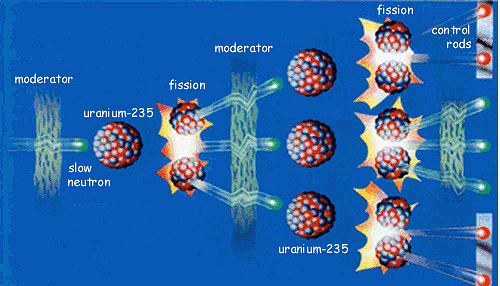
Why does this nuclear reaction produce energy?
Einstein was the first scientist to talk about mass and energy being interconvertible. His famous equation is :
E = m c2
(where E is the energy, m is the mass, and c is the velocity of light).
The total mass of all the particles produced in the fission reaction is a little less than that of a 235U plus a neutron; the difference is released as energy. So each time a uranium-235 is split, a chunk of energy is released. The more atoms split, the more energy is released. If the chain reaction gets out of control, so much energy is produced that a nuclear explosion would occur, and this is how an atom bomb works.
 Does
this work with all uranium atoms?
Does
this work with all uranium atoms?
No. Natural uranium is 99.28% 238U and 0.72% 235U. Only the 235U atoms undergo this kind of fission.
What's the difference?
Both uranium atoms have 92 protons; 238U atoms have 146 neutrons and 235U atoms have 3 less.
 So
why don't nuclear power stations explode, just like atom bombs?
So
why don't nuclear power stations explode, just like atom bombs?
Nuclear power stations have to have effective control devices (such as the control rods in the fission diagram earlier) that regulate how many neutrons are flying round the reactor, by absorbing any excess when the fission process is getting too fast.
How do power stations use the energy produced by fission?
Heat is removed from the nuclear reactor by a circulating coolant; the hot coolant is used to boil water, making steam. This drives a turbogenerator to make electricity.
What is all the fuss about nuclear waste?
The atoms formed when uranium atoms are split up are usually very radioactive. The "used" fuel rods from a reactor [discarded when about 25% of the uranium has undergone fission] are kept in a cooling pond for months for the more intensely radioactive atoms to decay and release most of their energy. Then they have to be processed to separate "unused" uranium atoms from the remaining fission products that have to be stored safely in barrels, often in underground bunkers (see photo, right).
All nuclear reactors are man-made, right?
In 1972, it was discovered that the uranium content in a mine at Oklo in Gabon (Africa) was very low in 235U. The only acceptable explanation is that some time in the past millions of years ago pockets of ore were formed that contained enough 235U for natural nuclear reactors to be formed (235U made up 3% of natural uranium at that time). Isotopes of fission products of 235U have been found in the ore, in just the exact amounts expected to confirm this theory.
Hiçbir yazı/ resim izinsiz olarak kullanılamaz!! Telif hakları uyarınca bu bir suçtur..! Tüm hakları Çetin BAL' a aittir. Kaynak gösterilmek şartıyla siteden alıntı yapılabilir.
The Time Machine Project © 2005 Cetin BAL - GSM:+90 05366063183 -Turkiye/Denizli
Ana Sayfa /
index /Roket bilimi /![]() E-Mail /CetinBAL/Quantum Teleportation-2
E-Mail /CetinBAL/Quantum Teleportation-2
Time Travel Technology /Ziyaretçi Defteri /UFO Technology/Duyuru